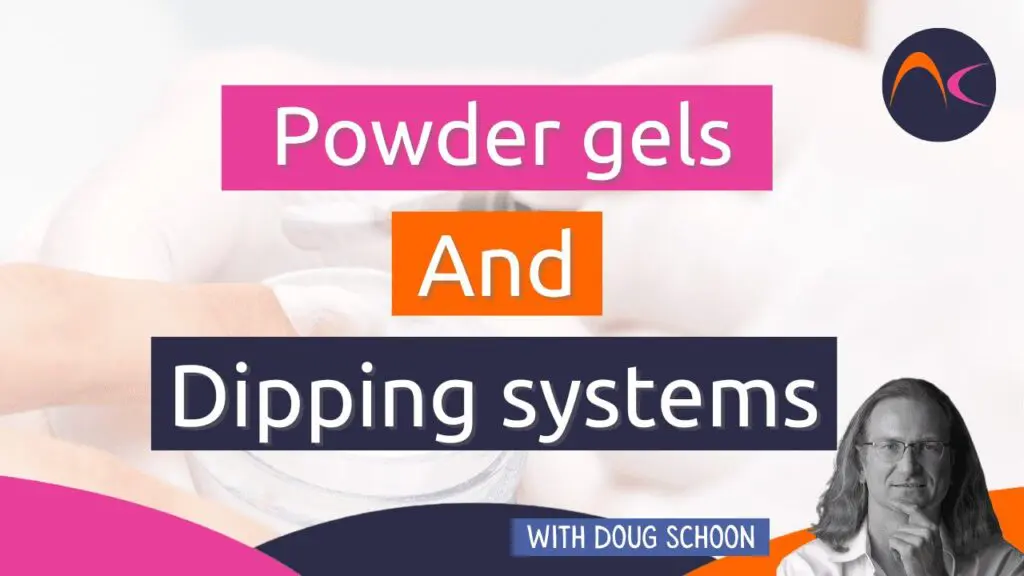I get a lot of questions about products that look like a “gel” when applied but are then dipped into a powder. These are called “powder gels”. However, this same name is used to describe two different types of nail coatings. In other words, there are two different nail services that are both considered to be “powder gels”.
One example is when a nail pro sprinkles acrylic powder over the surface of a UV gel coating before UV curing. Why is this done? This isn’t likely to enhance any of the properties of a UV gel coating or make it any more durable. Some claim this makes the nail coating more susceptible to solvents and therefore easier to remove. Using UV gel in this way is an improvement over the original “dip powder” systems that were first popular in New York City salons during the early 1990s. Versions of these original dipping systems are still in use today. Originally, salons began applying cyanoacrylate adhesives (glue) to the nail plate. After that, nail pros would dip the entire finger into the acrylic powder they used for liquid and powder enhancements.
These are non-UV curing systems and are called “dipping” systems. They are based mostly on cyanoacrylate monomers, which are members of the acrylic chemical family. Cyanoacrylate nail coatings lack strength/durability and they break down quickly. Cyanoacrylate monomers link together to form hard polymers; so why do they break down so readily? Cyanoacrylate-based polymers are highly sensitive to water/moisture. They don’t last long when repeatedly or excessively exposed to them in any fashion. That is why the newer dipping systems rely instead on UV gels, rather than cyanoacrylate monomers. UV gels are mostly based on urethane acrylate resins, which are also members of the acrylic chemical family. Both urethane acrylate and urethane methacrylate resins form hard polymer nail coatings that are much more water-resistant and durable than cyanoacrylate-based nail coatings.
Despite some limitations, cyanoacrylate monomers (aka resin) are great for many purposes in nail salons, e.g. “wrap” nail coatings with embedded fiberglass or silk. Modified cyanoacrylates are used as “glue” to adhere artificial nail tips or decorative objects to the natural nail. What makes cyanoacrylates extra sensitive to moisture and solvents? They don’t form cross-linked polymer structures upon cure! Examples of cross-linked nail coatings are two-part monomer liquid/polymer powder and UV cured nail coatings. Cross-links between the polymer chains make nail coatings highly resistant to attack by water or other solvents. Exposure to warm water, e.g. jacuzzis or hot baths, will accelerate the breakdown of cyanoacrylate nail coatings and adhesives.
Nail pros embed fiberglass or silk material into the cyanoacrylates monomer to increase the strength and durability of the nail coating. In contrast, dipping systems replace fiberglass/silk material with acrylic powder to provide some additional strength. Without using fiberglass, silk, or acrylic powder, cyanoacrylate nail coatings are not nearly as durable and would make poor nail coatings.
In my opinion, it is a big negative for dipping systems to require clients to dip their fingers into a powder. Many people, including some government regulators and clients, view this to be unsanitary. Salons that dip multiple clients’ fingers into the same powder have an increased risk of transmitting an infectious microorganism that can lead to an infection. If your region has regulations against “double-dipping” into cosmetics to perform client services, then a dipping system may be in violation of those regulations. Some of the newer systems very wisely recommend that nail pros should sprinkle the acrylic powder over the top of the nail, rather than dipping it. I don’t recommend dipping multiple clients’ nails into the same powder, especially given that many salons don’t require clients to wash their hands or nails before receiving a service.
Finally, it is a myth that some cyanoacrylates release formaldehyde when they undergo service breakdown. This is false and extremely unlikely to occur in the salon setting. Cyanoacrylates in general are considered safe for salon use. I do believe any of these types of nail services, whether they are called powder gels or dipping systems, are generally safe when properly used. I also believe that nail professionals should always perform their nail services in a sanitary fashion. This responsibility should be their first priority.


